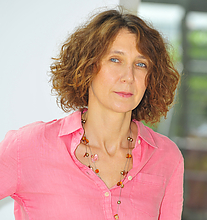 A University of Maryland expert in computer vision and robotics has received funding from the National Science Foundation (NSF) to create a global research network focused on advancing neuromorphic engineering.
A University of Maryland expert in computer vision and robotics has received funding from the National Science Foundation (NSF) to create a global research network focused on advancing neuromorphic engineering.
Cornelia Fermüller, an associate research scientist in the University of Maryland Institute for Advanced Computer Studies, is principal investigator of the $1.75 million award. The funding comes from NSF’s Office of International Science and Engineering and the Directorate for Social, Behavioral, and Economic Sciences.
Neuromorphic engineering is about designing and computing with analog and mixed-signal hardware and sensors that mimic neuro-biological architectures present in biological nervous systems. These include neural systems used for perception, action and cognition, the three areas that Fermüller’s team will concentrate on.
She is joined on the project by UMD faculty members Shihab Shamma, a professor of electrical and computer engineering and Behtash Babadi, an associate professor of electrical and computer engineering. Ralph Etienne-Cummings and Andreas Andreou, both professors of electrical and computer engineering at Johns Hopkins University, are also part of the team.
Artificial intelligence is becoming ubiquitous in modern life, Fermüller says. To build AI-driven systems under the current model, large amounts of energy are required for computing and sensing. This can cause environmental problems and challenges for small-sized systems, as well as privacy issues.
Neuromorphic engineering offers an alternative by seeking to understand principles of biological brains and build on their basis artificial systems using low-power hardware and software solutions. While its advantages have been demonstrated, Fermüller says further advances are necessary to transform the approach into accessible technology.
The goal of the NSF-funded project, called NeuroPacNet, is to work with international experts from seven global networks, establishing the foundations for building neuromorphic systems that can robustly process real-world signals in time and adapt to changes.
This “network of networks” will facilitate the development of new methods and approaches for intelligent system design and prepare the next generation of leaders in neuromorphic science and technology, Fermüller says.
“To make great advances, we need a true exchange of ideas, and scientists with different skills working together,” she says. “Our network will fund collaboration, among others, for an immersive hands-on workshop and fellowship program.”
Fermüller adds that as different industries adopt neuromorphic software and hardware, society will have access to new applications, such as computing on cell phones, neuro-prosthetics, intelligent hearing aids, and smart sensory systems with predictive capabilities.
“Our team spans a wide range of the expertise required to create the foundations for neuromorphic intelligence,” she says. “I am very excited about this collaboration and cannot wait to see what we can accomplish together through the creation of this network.”
—Story by Melissa Brachfeld